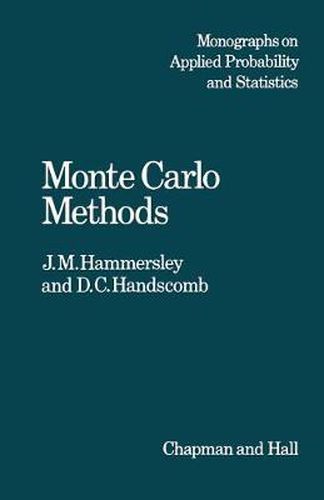Readings Newsletter
Become a Readings Member to make your shopping experience even easier.
Sign in or sign up for free!
You’re not far away from qualifying for FREE standard shipping within Australia
You’ve qualified for FREE standard shipping within Australia
The cart is loading…






This title is printed to order. This book may have been self-published. If so, we cannot guarantee the quality of the content. In the main most books will have gone through the editing process however some may not. We therefore suggest that you be aware of this before ordering this book. If in doubt check either the author or publisher’s details as we are unable to accept any returns unless they are faulty. Please contact us if you have any questions.
This monograph surveys the present state of Monte Carlo methods. we have dallied with certain topics that have interested us Although personally, we hope that our coverage of the subject is reasonably complete; at least we believe that this book and the references in it come near to exhausting the present range of the subject. On the other hand, there are many loose ends; for example we mention various ideas for variance reduction that have never been seriously appli(:d in practice. This is inevitable, and typical of a subject that has remained in its infancy for twenty years or more. We are convinced Qf:ver theless that Monte Carlo methods will one day reach an impressive maturity. The main theoretical content of this book is in Chapter 5; some readers may like to begin with this chapter, referring back to Chapters 2 and 3 when necessary. Chapters 7 to 12 deal with applications of the Monte Carlo method in various fields, and can be read in any order. For the sake of completeness, we cast a very brief glance in Chapter 4 at the direct simulation used in industrial and operational research, where the very simplest Monte Carlo techniques are usually sufficient. We assume that the reader has what might roughly be described as a ‘graduate’ knowledge of mathematics. The actual mathematical techniques are, with few exceptions, quite elementary, but we have freely used vectors, matrices, and similar mathematical language for the sake of conciseness.
$9.00 standard shipping within Australia
FREE standard shipping within Australia for orders over $100.00
Express & International shipping calculated at checkout
This title is printed to order. This book may have been self-published. If so, we cannot guarantee the quality of the content. In the main most books will have gone through the editing process however some may not. We therefore suggest that you be aware of this before ordering this book. If in doubt check either the author or publisher’s details as we are unable to accept any returns unless they are faulty. Please contact us if you have any questions.
This monograph surveys the present state of Monte Carlo methods. we have dallied with certain topics that have interested us Although personally, we hope that our coverage of the subject is reasonably complete; at least we believe that this book and the references in it come near to exhausting the present range of the subject. On the other hand, there are many loose ends; for example we mention various ideas for variance reduction that have never been seriously appli(:d in practice. This is inevitable, and typical of a subject that has remained in its infancy for twenty years or more. We are convinced Qf:ver theless that Monte Carlo methods will one day reach an impressive maturity. The main theoretical content of this book is in Chapter 5; some readers may like to begin with this chapter, referring back to Chapters 2 and 3 when necessary. Chapters 7 to 12 deal with applications of the Monte Carlo method in various fields, and can be read in any order. For the sake of completeness, we cast a very brief glance in Chapter 4 at the direct simulation used in industrial and operational research, where the very simplest Monte Carlo techniques are usually sufficient. We assume that the reader has what might roughly be described as a ‘graduate’ knowledge of mathematics. The actual mathematical techniques are, with few exceptions, quite elementary, but we have freely used vectors, matrices, and similar mathematical language for the sake of conciseness.